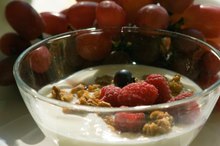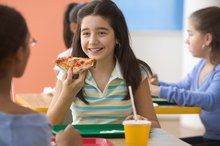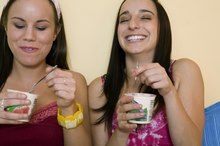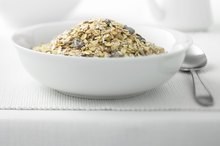A Meal Plan for Preschoolers
A preschooler's meal plan must sustain rapid growth and healthy development as well as foster positive attitudes toward food. The average 3- to 5-year-old preschooler grows 3 to 5 inches and gains 4 to 6 lbs. per year. Energy and protein needs change with normal growth spurts and average about 1,400 calories per day.
Food Goals
The design of the preschool meal plan ensures intake of needed nutrients and sufficient energy for normal growth and development. Food preferences and food aversions develop early, so the meal plan offers a wide variety of tastes and textures in child-sized portions to help children grow up healthy, develop healthy eating habits and try new foods.
Pyramid Meal Plan
The Ideal Diet for 4-Year-Old Kids
Learn More
The United States Department of Agriculture's (USDA) ChooseMyPlate.gov Daily Food Plan for Preschoolers provides individualized meal and snack patterns to meet the needs of preschoolers based on their age, sex and activity level 2. A 1,400-calorie meal plan includes 5 oz. grains, 1 1/2 cups vegetables, 1 1/2 cup fruit, 2 cups milk and 4 oz. meat and beans per day. A wide variety of food choices can fit this plan.
- The United States Department of Agriculture's (USDA) ChooseMyPlate.gov Daily Food Plan for Preschoolers provides individualized meal and snack patterns to meet the needs of preschoolers based on their age, sex and activity level 2.
- A 1,400-calorie meal plan includes 5 oz.
Breakfast and Morning Snack
A 1,400 calorie meal plan for preschoolers could include a breakfast of 1 oz. grains, 1/2 cup milk and 1 oz. meat and beans. For example, give one scrambled egg and 1/4 cup dry oatmeal cooked with 1/2 cup low-fat milk. For a morning snack of 1/2 cup fruit and 1/2 cup milk, offer half of a small apple and low-fat string cheese or half of a medium pear and 1/2 cup pudding.
- A 1,400 calorie meal plan for preschoolers could include a breakfast of 1 oz.
- For a morning snack of 1/2 cup fruit and 1/2 cup milk, offer half of a small apple and low-fat string cheese or half of a medium pear and 1/2 cup pudding.
Lunch and Afternoon Snack
How Many Calories Should a 6-Year-Old Boy Have?
Learn More
Lunch could include 2 oz. grains, 1/2 cup vegetables, 1/2 cup fruit and 1/2 cup milk. For instance, a child may enjoy a grilled cheese sandwich made with one slice each of whole wheat bread and low-fat cheese and a salad made with 1/2 cup each of salad greens or lettuce and mandarin oranges and ¼ cup chopped tomato. For an afternoon snack of 1/2 cup vegetables, 1/2 cup fruit and 1 oz. beans, try offering 1/2 cup celery sticks spread with 1 tbsp. peanut butter and 1/4 cup raisins or mixed dried fruit.
- grains, 1/2 cup vegetables, 1/2 cup fruit and 1/2 cup milk.
- beans, try offering 1/2 cup celery sticks spread with 1 tbsp.
Dinner
Dinner typically includes 2 oz. grains, 1/2 cup vegetables, 1/2 cup low-fat milk and a 2 oz. choice from the meat and beans group. A dinner menu for this meal plan might include 2 oz. roast beef with 1/4 cup each of baked potato and green beans and two small slices of French bread with 1/2 cup low-fat milk.
- Dinner typically includes 2 oz.
- grains, 1/2 cup vegetables, 1/2 cup low-fat milk and a 2 oz.
Considerations
Growth spurts and physical activity affect a preschooler’s appetite. Treat excessive intake by increasing physical activity and improving food choices. Offer a variety of foods in child-sized portions and make meal time pleasant. Preschool eating experiences affect the development of positive attitudes toward food and making food choices. Preschoolers may be “picky” eaters, but helping in the kitchen or garden improves acceptance of new and healthful foods. Respond to a child’s hunger and satiety signals and avoid using food as reward or punishment.
- Growth spurts and physical activity affect a preschooler’s appetite.
- Preschoolers may be “picky” eaters, but helping in the kitchen or garden improves acceptance of new and healthful foods.
Related Articles
References
- Nutrition Across the Life Span; Mary Kay Mitchell; 2003
- USDA ChooseMyPlate.gov: Daily Food Plan for Preschoolers
- Nutrition Through the Life Cycle, Third Ed.; Judith E. Brown; 2008
Writer Bio
Norma DeVault, a registered dietitian, has been writing health-related articles since 2006. Her articles have appeared in the "Journal of the American Dietetic Association.” She holds a Doctor of Philosophy in human environmental sciences from Oklahoma State University and a Master of Business Administration from the University of Tulsa.









